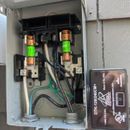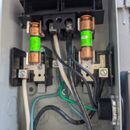HVAC surge protector installation
I recently had an issue with my split-air HVAC system and with the VERY kind help of those here, was able to ferret out the problem was with blown circuit boards and it was recommended that I install a Ditek surge protector. Got it the other day, and while I’m 99% sure I’ve installed it correctly, I’d be most grateful if those, here, with corresponding experience would just have a look and confirm that it’s right before I energize that circuit.
GBA Detail Library
A collection of one thousand construction details organized by climate and house part











Replies
Forgot to add the install illustration provided with the protector. Also, the line in from the panel is on the lower right. Line on the lower left is to the HVAC outdoor unit.
I can’t quite tell from your pic which side of the fuses you installed the protector on, but it should be on the LOAD side of the fuses which is the same side the air conditioner is connected to. You want it to go like this “incoming power -> shutoff switch (if you have one) -> fuses -> protector and air conditioner”
One black lead from the protector goes to each of the two hot conductors. Looks like you have the right here. Those white wires should be tagged as hots, usually using some black or red tape, since this is almost certainly a 240v circuit. Green wire from the protector goes to ground (usually a bare wire). It looks like you have it wired correctly provided that you connected it to the LOAD side of the fuses as I mentioned earlier.
Note that I highly recommend installing a protector on your main panel. Usually I’d install the protector there and not at the air conditioner, but it will work for the air conditioner the way you did it. I’d still recommend one on your main panel for full home protection, and it won’t hurt to have one there AND one on your air conditioner disconnect.
I can’t tell from your pic, but there should be a rubber washer between the protector and the fuse box if this is outdoors. Make sure the protector says it’s ok being installed outdoors too — I’ve never installed one outdoors myself.
Bill
Bill, thank you again! I installed it on the wrong side, then. I don't even want to think about what might/could have happened if I had energized the circuit with the protector installed on the incoming, before-the fuses side of the cut-off . Maybe nothing, but I wouldn't be getting the benefit of the protector, I'm guessing
This protector is the exact Ditek DTK120/240CM+ model you recommended in response to my other post ("Split air handlers fuses blown"), and does have the rubber washer and is rated for outdoor use. What model did you use for your whole house panel installation? I really can't thank you enough for your help. I'm off to correct my mistake and test it out.
If you turned it on on the wrong side of the fuses everything would have been fine. The reason it is supposed to be downstream of the fuses is that the protector works by “shorting out” line transients, and the fuses protect the protector in case the protector takes a BIG hit and dies. The fuses don’t save the protector itself, the protector is a sacrificial device that will die to protect your equipment. The fuses are there to protect your home in case of a problem inside the protector.
The model I recommended is the one on my panel at home (I actually went down to the basement to get the model number when I posted about it before :-). The big polyphaser protector I also use is around $800 or so so not too many will want to use that one. The ditek is great for 99% of installations. I use the beefy polyphaser for two reasons: 1, I’m in an area with frequent lightning, and 2, I’m paranoid since I work in an industry that takes lots of lightning hits to equipment and I’ve seen the damage that is done when the protection is insufficient. I also have a ground ring around my house (buried 2 gauge copper wire (about 3/8” diameter) with an 8 foot ground rod welded to it every 16 feet). I have had trees near my house take direct lightning hits in the past, I’ve seen the lightning leave the tree to enter wires into the house, and I’ve had all my electronic equipment survive without problems. Good protection is not cheap, but most certainly CAN handle a direct lightning strike without damage.
Bill
Depending on whether or not this is being inspected, one thing an inspector might be curious about is whether the lugs on the disconnect are specified by the manufacturer for multiple conductors in a single lug.
Just a thought...
WOW! That's serious protection, and thanks for all that info! It's much appreciated. Lightning strikes were uncommon in my area east of Seattle, but becoming more so as the climate is changing. The Ditek unit I got says it's for HVAC protection, but are you saying the same model can provide some degree of whole house protection when installed on the breaker panel, or would that be another model?
They aren’t very particular, really. All they really do is clamp (short out) high voltage spikes over their threshold voltage. The model I recommended is fine for whole-home use. There are different variations, but mostly they’re for different voltage and phase configurations. You can use the same one on your main panel if you want to.
Bill
Such protection should be standard practice.
FWIW, I've had more success with avoiding electronics damage since I also added a series voltage protector (uses a relay to interrupt power for several minutes whenever it is unstable).
Thank you Jon. I'll look into that, as well.
Agree, any HVAC equipment with ECM motors or inverters are especially prone to damage. I've got an Eaton whole home protection device on my main panel, but I'm considering adding a second downstream one for my heat pump.
My major appliances and electronics are all on point of use protectors as a second defense.
Just to add this to the thread:
Single point grounding is vital if you really want your home to be safe from things like lightning. Make sure all wires entering your home enter at the same point (usually near the electric meter), and make sure they are all grounded at that point. Make sure the ground connection is solidly made to a copper cold water line, steel well casing, or ground rods. If you connect to a metallic water pipe, make sure there are no dielectric unions (these have a plastic piece to prevent metal to metal contact) between the ground connection and the exterior part of the pipe. Ideally, you’d connect all of these grounds together if you have more than one.
One ground rod is rarely enough. You almost always need at least two. Multiple ground rods should be spaced twice their length apart. Don’t use mechanical (acorn clamps) connections outdoors because they loosen over time. Use cadweld shots to make welded connections. Erico makes “cadweld one-shots” if you only have a few to do so that you don’t be have the expense of the mold and tooling that would otherwise be needed. One-shots light off and then you wack the temporary mold with a hammer to remove it. Each one-shot makes one welded connection. Use solid or 7 strand copper wire for ground connections. 7 strand is more corrosion resistant than 19 strand in the larger gauges, but usually needs to be special ordered. Never use aluminum wire for grounding, and never use galvanized ground rods since they degrade in many types of soil.
If you’re off grid, you’re probably also on a water well. If it’s a steel casing, ground to it. If it’s a PVC casing, use ground rods and put a protector on the wires coming from your well pump if it’s a submersible type. You still need a single point ground for any wires entering your home (which includes satellite and wireless internet wiring), and you still need ground rods.
Solar systems are like antennas and can collect large amounts of energy from nearby lightning strikes. Special protectors are available. Running the wiring from the solar panels in steel conduit and grounding it will help limit the impulse that can get to wherever those wires go.
Bill